Co-Located Conference AgendasNGS, SCA, SMA & Mass Spec: Research to Diagnostics 2016 | Point-of-Care Diagnostics & Global Health World Congress 2016 |  Other Track Agendas Other Track AgendasLab-on-a-Chip and Microfluidics: Companies, Technologies and Commercialization | Lab-on-a-Chip and Microfluidics: Emerging Themes, Technologies and Applications |

Monday, 26 September 201609:00-12:00 Microfluidics and Lab-on-a-Chip (LOAC) for
Point-of-Care (POC) Diagnostics Applications: Technologies,
Applications, Research Trends [Pre-Conference Training Course]
Presented by Dr. Holger Becker, microfluidic ChipShop GmbH.
Separate Registration Required for this Pre-Conference Training Course. | 12:00-14:30 Luncheon Training Course: Basic Principles in
Lab-on-a-Chip (LOAC) Technologies for the Study of Circulating
Biomarkers: Applications in Liquid Biopsies [Pre-Conference Training
Course]
Presented by Professor Steve Soper, Professor and Director, University of North Carolina-Chapel Hill.
Separate Registration Required for this Training Course. | 14:30 | Conference Registration, Conference Materials Pick-Up and Networking | |
Session Title: Conference Plenary Session -- Convergence of Technologies in Microfluidics, Diagnostics and Single Cell Analysis |
| | 15:30 |  | Keynote Presentation The Personalized Health Care Environment: How in vitro Diagnostics, Mobile Health and Medical Devices will Converge to Improve Health Care
Alan Wright, Chief Medical Officer, Roche Diagnostics Corporation, United States of America
|
| 16:00 | 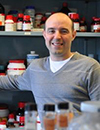 | Keynote Presentation Digital Microfluidics: A Platform Whose Time Has Come
Aaron Wheeler, Canada Research Chair of Bioanalytical Chemistry, University of Toronto, Canada
Digital microfluidics is a fluid-handling technique in which droplets
are manipulated by electrostatic forces on an array of electrodes coated
with a hydrophobic insulator. In this talk, I will present recent
results from my group’s work with digital microfluidics, with an
emphasis on the topics covered in this unique venue. Specifically, I
will demonstrate how digital microfluidics is particularly well-suited
for Lab on a Chip applications, given its ability to automate diverse
laboratory processes on a generic, programmable platform. Likewise, I
will report on our work using digital microfluidics for Point of Care
Diagnostics and Global Health, reporting on the results of a field trial
for measles and rubella diagnostics at refugee sites in Kenya. Finally,
I will describe how digital microfluidics is emerging as a useful tool
for Single-Cell Analysis and for integration with Mass Spectrometry to
answer questions about cell heterogeneity and cell-cell communication.
Through these examples, I will make the case that digital microfluidics
is emerging as a useful new tool for the next generation of analytical
techniques, across a wide range of applications. |
| 16:30 |  | Keynote Presentation Microfluidics and Sensors: New Tools for Real-Time Clinical Monitoring
Martyn Boutelle, Professor of Biomedical Sensors Engineering, Imperial College London, United Kingdom
A goal for modern medicine is to protect vulnerable tissue by monitoring
the patterns of changing physical, electrical and chemical changes
taking place in tissue - ‘multimodal monitoring’. Clinicians hope such
information will allows treatments to be guided and ultimately
controlled based on the measured signals. Microfluidic lab-on-chip
devices coupled to tissue sampling using microdialysis provide an
important new way for measuring real-time chemical changes as the low
volume flow rates of microdialysis probes are ideally matched to the
length scales of microfluidic devices. Concentrations of key biomarker
molecules can then be determined continuously using either optically or
electrochemically (using amperometric, and potentiometic sensors).
Wireless devices allow analysis to take place close to the patient.
Droplet-based microfluidics, by digitizing the dialysis stream into
discrete low volume samples, both minimizes dispersion allowing very
rapid concentration changes to be measured, and allows rapid transport
of samples between patient and analysis chip. This talk will overview
successful design, optimization, automatic-calibration and use of both
continuous flow and droplet-based microfluidic analysis systems for
real-time clinical monitoring, using clinical examples from our recent
work. |
| 17:00 |  | Keynote Presentation High-Performance Rapid Diagnostic Tests
Bernhard Weigl, Director, Center for In-Vitro Diagnostics, Intellectual Ventures/Global Good-Bill Gates Venture Fund, United States of America
Lateral flow and similar rapid diagnostic assays (LFAs) are easy to use
and manufacture, low cost, rapid, require little or no equipment to
operate, and do not need to be refrigerated. However, they are generally
not considered to be very sensitive or able to provide a quantitative
result. Our group believes that this lack of sensitivity is not a
fundamental property of LFAs but rather a consequence of the way they
are developed, manufactured, and marketed. Historically, most lateral
flow tests were developed and optimized by relatively small
manufacturers with limited R&D capabilities and budgets, and were
generally used only for analytical targets prevalent at high
concentration in patient’s samples that were relatively easy to measure.
In contrast, our group’s mission is to develop LFA-based assays for use
in global health applications that are as sensitive as the best
conventional diagnostic assays (in some cases even better) while
retaining all their cost, simplicity, and usability advantages. |
| 17:30 | 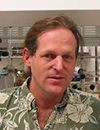 | Keynote Presentation Technologies for Personalizing Cancer Immunotherapies
James Heath, Elizabeth W. Gilloon Professor of Chemistry, California Institute of Technology (CalTech), United States of America
Cancer immunotherapy, which has taken virtually all aspects of oncology
by storm over the past few years, is based upon using cellular or
molecular therapies to promote tumor cell/immune cell interactions. At
the heart of this therapy are the T cells that actually do the tumor
cell killing, and the tumor antigens that are recognized by those T
cells. Recent work has shown that neoantigens play critical roles in
many immunotherapy successes. Neoantigens are tumor antigens that are
fragments of mutated proteins expressed by the cancer cells, and contain
those point mutations. They are presented in the clefts of major
histocompatibility molecules (MHCs) by many of the cells in the tumor,
where they may be recognized by neoantigen-specific T cell populations.
In this presentation, I will discuss how various micro and
nanotechnologies are being harnessed to identify, for a given patient
which neoantigens are actively recruiting T cells into the tumor, and to
carry out a deep molecular analysis of those neoantigen-specific T
cells. I will further discuss how that information can then be
harnessed for personalized cancer immunotherapies in the form of
neoantigen-based vaccines, or engineered T cell receptor adoptive cell
transfer therapies. |
| 18:00 |  | Keynote Presentation Wearable Eccrine Sweat Biosensing: Uncovering The Real Challenges That Lie Ahead
Jason Heikenfeld, Professor and VP Operations, UC Office of Innovation, University of Cincinnati, United States of America
Despite the many ergonomic advantages of eccrine perspiration (sweat) compared to other biofluids (particularly in “wearable” devices), sweat remains an underrepresented source of biomarker analytes compared to the established biofluids blood, urine, and saliva. Upon closer comparison to other non-invasive biofluids, the advantages may even extend beyond ergonomics: sweat might provide superior analyte information. A number of challenges, however, have historically kept sweat from its place in the pantheon of clinical samples. These challenges include very low sample volumes (nL to µL), unknown concentration due to evaporation, filtration and dilution of large analytes, mixing of old and new sweat, and the potential for contamination from the skin surface. More recently, rapid progress in “wearable” sweat sampling and sensing devices has resolved several of the historical challenges. However, this recent progress has also been limited to high concentration analytes (µM to mM) sampled at high sweat rates (>1 nL/min/gland, e.g. athletics). Progress will be much more challenging as sweat biosensing moves towards use with sedentary users (low sweat rates or not sweating at all) and/or towards low concentration analytes (pM to nM). Fortunately, none of the remaining challenges appear to be fundamentally blocking, and scientific and engineering innovations have the opportunity to enable broader application of sweat biosensing technology. |
| 18:30 |  | Keynote Presentation The Challenge in Building Phenotype Body-on-a-Chip Models for Toxicological and Efficacy Evaluations in Drug Discovery as well as Precision Medicine
James Hickman, Professor, Nanoscience Technology, Chemistry, Biomolecular Science and Electrical Engineering, University of Central Florida; Chief Scientist, Hesperos, United States of America
The utilization of human-on-a-chip or body-on-a-chip systems for toxicology and efficacy that ultimately should lead to personalized, precision medicine has been a topic that has received much attention recently. Key characteristic needed for these systems are the ability for organ-to-organ communication in a serum-free recirculating medium and incorporation of induced pluripotent stem cells that allow for understanding genetic variation as well as to construct systems utilizing stem cells from diseased patients and also from individuals. Additional characteristics that have been discussed are functional readouts that would enable non-invasive monitoring of organ health and viability for chronic studies that now are only possible in animals or humans at this time. In addition, in order to achieve wide spread adoption of these technologies they should also be low cost, easy to use and reconfigurable to allow flexibility for platforms to be examined with small variation. Our group, in collaboration with Dr. Michael Shuler from Cornell University, has been constructing these systems with up to 6 organs and have demonstrated long-term (>28 days) evaluation of drugs and compounds, that have shown similar response to results seen from clinical data or reports in the literature. We have accomplished the construction of these systems utilizing mostly 2D systems in serum-free medium with functional readouts that employs a pumpless platform that enables ease of use of these assays. Our group’s ability to control the interface between the biological and non-biological components in these systems has enabled the straightforward integration of multiple cell types in the same platform. Results with the functional multi-organ systems will be presented as well as results of five workshops held at NIH to explore what is needed for validation and qualification of these systems by the FDA and EMA. |
| 19:00 | Conference Opening Reception with Beer, Wine and a Light Dinner Sponsored by Veryst Engineering, LLC | 20:00 - 22:00 Dinner Training Course: Microfluidics for 3D-Printing
and Biofabrication: Technologies and Applications
- Presented by Professor Albert Folch, University of Washington
- Dinner will be served
- Separate Registration Required for this Training Course
|
Tuesday, 27 September 201607:45 | Conference Registration, Conference Materials Pick-Up, Morning Coffee and Breakfast Pastries in the Exhibit Hall | |
Session Title: Companies, Commercial Offerings and Technologies in Lab-on-a-Chip and Microfluidics |
| | 09:00 |  Technology Spotlight: Technology Spotlight:
Need for Surface Tension Preparation for Microfluidic Devices
Bill Moffat, Founder & CTO, Yield Engineering Systems, Inc. (YES)
This presentation will discuss the need for surface tension modification for successful microfluidic devices. YES has experience with multiple gas and plasma mode preparation and multiple chemical reactants for vapor phase deposition. Their process equipment allows any combination to be used for the optimum surface conditions.
| 09:30 |  Technology Spotlight: Technology Spotlight:
A Unique Collaboration For Rapid Prototyping Injection Molded Microfluidic Devices and a Case Study of Microfluidic Cartridge for Pathogen Separation and Detection
Markus Ebster, Vice President Sales & Marketing, z-microsystems®, Austria
Nick Lewis, Sales Representative, Z Microsystems Americas, United States of America
z-microsystems from Austria and the University of Toronto, Canada began a unique development collaboration in late 2015 combining Silicon wafer technology and a new type of injection mold-making to provide a commercially viable rapid prototyping service to injection mold microfluidic devices. This presentation will outline details of the collaboration and successes so far.
| 10:00 |  Technology Spotlight: Technology Spotlight:
Injection Molding, a High Volume Solution for Microfluidic Cartridges
Mark Kinder, President, Plastic Design Corporation
This talk will discuss the advantages, limitations, scalability, material options, and design for manufacturability factors for injection molded fluidics.
| 10:30 | Coffee Break and Networking in the Exhibit Hall: Visit Exhibitors and Poster Viewing | 11:15 |  Technology Spotlight: Technology Spotlight:
Scalable Wafer Level Production of Consumables Made of Non-CMOS Compatible Materials on Glass, Challenges and Opportunities Utilizing a Foundry Concept
Alexios Tzannis, Business Development Manager Life Sciences, IMT Microtechnologies
For many microfluidic applications glass remains the material of choice. Glass is inert to most chemicals, has unsurpassed and well defined optical properties and good temperature and pressure stability. Glass components, however, have a reputation for being too expensive for high volume applications. In this presentation we show that this paradigma is wrong, if manufacturing technology developed for semiconductors is applied. The manufacturing of these components requires the whole portfolio of wafer-level packaging (WLP) processes, such as generation of (sub-)µm structures, through glass Vias (TGVs), temporary and/or permanent bonding. Life Science and Lab-on-a-Chip (LOAC) applications often require the integration of structured electrodes or waveguides. Therefore patterning of non-CMOS compatible materials as well as the compatibility of the processes to the constraints biological matter is needed. Whilst the mass production of sub µm patterns is well established in the semiconductor industry, semiconductor fabs are limited to using CMOS compatible materials. IMT of Switzerland has implemented a fully automated manufacturing line that allows cost effective mass manufacturing of consumables in substrate materials like borosilicate or fused silica wafers. The applied processes offer a high degree of freedom in the design of the consumable. In this presentation we discuss the challenges and solutions of implementing WLP processes for LOAC products.
| 11:45 | Microfluidics for Point-of-Need Testing: Market & Technology Analysis
Sébastien Clerc, Technology & Market Analyst, Microfluidics & Medical Technologies, Yole Développement, France
| 12:15 | Networking Lunch in the Exhibit Hall: Visit Exhibitors and Poster Viewing | |
Session Title: Innovations in Microfluidics/LOAC Device Development and Applications |
| | 13:30 |  | Keynote Presentation Microraft Array Platform for the Selection of Lymphocytes Based on Target-Cell Killing
Nancy Allbritton, Frank and Julie Jungers Dean of the College of Engineering and Professor of Bioengineering, University of Washington in Seattle, United States of America
Adoptive cellular therapy (ACT) is an emerging therapeutic in which
cytotoxic T lymphocytes (CTLs) that recognize tumor cell epitopes are
introduced into patients providing immunity against the cancer cells.
For ACT to succeed, CTLs with high tumor-killing efficiency must be
identified, isolated, and characterized. Current technologies do not
enable simultaneous assay of cell behavior or killing followed by
recovery of the most efficient killer cells. A microraft array
technology that measures the ability of individual T cells to lyse a
population of target cells followed by sorting of living cells into a
multi-well plate for expansion and characterization was developed. The
microraft array platform was combined with image processing and analysis
algorithms to track and monitor killing assays over many hours.
Automated cell collection was incorporated into the platform for facile
cell collection from the array. As a proof of principle, human T cells
directed against an influenza antigen were co-cultured with antigen
presenting target cells on the microraft arrays. Target cell killing was
measured by tracking the appearance of dead cells on each microraft
over time. Microrafts with a single CTL demonstrating the greatest rate
of target cell death were identified, cloned, and influenza-antigen
reactivity confirmed. The platform is readily modified to measure the
antigen-specific activity of individual cells within a bulk CTL culture
or the cell heterogeneity within a population of gene-engineered T
cells. |
| 14:00 |  Technology Spotlight: Technology Spotlight:
Critical Manufacturability Considerations in Automating Laboratory Assays in Microfluidic Disposable & Instrument Systems
Luke Helm, Director of Business Development, Symbient Product Development
Practical and actionable information for CTO’s, CSO’s, scientists and engineers who need to develop low cost microfluidic cartridges or chips (instrument-driven or not) to implement assays developed in the laboratory. Topics include: 1. The manufacturability of micron scale features such as microfluidic channels. Costs considerations thereof in both development and production. Solutions to these challenges. 2. Microfluidic Volumes - how small is too small? Metering small volumes and tolerance considerations. Balancing reagent cost vs cartridge cost. Mixing characterization. 3. Workflow Considerations and Tradeoffs. Defining workflow for automation. On-instrument vs on-cartridge functions. Reagent considerations including storage and integration.
| 14:30 |  Technology Spotlight: Technology Spotlight:
Deposition of Biological Samples in Picoliter Volumes for Scalable Biosensor Production
Joshua Cantlon, Sales Representative, Scienion AG
A number of technologies have evolved to enable the development and manufacturing of a variety of different biosensing devices for medical diagnostics, environmental monitoring, and toxicity screening among others. In particular, loading of sensitive biological content onto sometimes microscopic sensing elements can be a real challenge requiring ultra-low volumes to be deposited with very high precision on extremely delicate surfaces. This presentation will illustrate how biologics can be accurately and reproducibly deposited to create high-quality multiplexed biological tests. Examples covering different platforms will include lateral flow strips, microarrays in microtiter plates, custom biochips and sensors, from R&D to manufacturing scale.
| 15:00 |  Technology Spotlight: Technology Spotlight:
5 Costly Surprises During Lab-on-a-Chip Development and How to Avoid Them
John Zeis, CEO, Toolbox Medical Innovations
If you've never developed a product, or if you're a veteran in product development, there are ALWAYS surprises that can derail, slow down, or increase costs. We will walk you through our 5 common surprises we've seen over the years and discuss how we help our customers mitigate the risks that reduce surprises plus, show you a case study on agile product development. You will walk away from this presentation with actionable takeaways to streamline your development process.
| 15:30 | Coffee Break and Networking: Visit Exhibitors and Poster Viewing | |
STRATEC Consumables Symposium on Innovations in Microfluidics and Lab-on-a-Chip and their Impact on Life Sciences and Diagnostics | Session Sponsors |
| | 16:00 | Introduction to the STRATEC Consumables Symposium and Topics Addressed in 2016 | 16:15 |  | Keynote Presentation Microfluidic Printing: From Combinatorial Drug Screening to Artificial Cell Assaying
Tingrui Pan, Professor, Department of Biomedical Engineering, University of California-Davis, United States of America
Microfluidic impact printing has been recently introduced, benefiting
from the nature of simple device architecture, low cost,
non-contamination, scalable multiplexability and high throughput. In
this talk, we will review this novel microfluidic-based droplet
generation platform, utilizing modular microfluidic cartridges and
expandable combinatorial printing capacity controlled by plug-and-play
multiplexed actuators. Such a customizable microfluidic printing system
allows for ultrafine control of the droplet volume from picoliters
(~10pL) to nanoliters (~100nL), a 10,000 fold variation. The high
flexibility of droplet manipulations can be simply achieved by
controlling the magnitude of actuation (e.g., driving voltage) and the
waveform shape of actuation pulses, in addition to nozzle size
restrictions. Detailed printing characterizations on these parameters
have been conducted consecutively. A multichannel impact printing system
has been prototyped and demonstrated to provide the functions of
single-droplet jetting and droplet multiplexing as well as concentration
gradient generation. Moreover, several enabling chemical and biological
assays have been implemented and validated on this highly automated and
flexible printing platform. In brief, the microfluidic impact printing
system could be of potential value to establishing multiplexed droplet
assays for high-throughput life science researchers. |
| 16:35 |  | Keynote Presentation Nanopore Sequencing for Real-Time Pathogen Identification
Kamlesh Patel, R&D Advanced System Engineering and Deployment Manager, Sandia National Laboratories, United States of America
As recent outbreaks have shown, effective global health response to
emergent infectious disease requires a rapidly deployable, universal
diagnostic capability. We will present our ongoing work to develop a
fieldable device for universal bacterial pathogen characterization based
on nanopore DNA sequencing. Our approach leverages synthetic
biofunctionalized nanopore structures to sense each nucleotide. We aim
to create a man-portable platform by combining nanopore sequencing with
advance microfluidic-based sample preparation methods for an
amplification-free, universal sample prep to accomplish multiplexed,
broad-spectrum pathogen and gene identification. |
| 16:55 |  | Keynote Presentation Polymer-based Nanosensors using Flight-Time Identification of Mononucleotides for Single-Molecule Sequencing
Steve Soper, Foundation Distinguished Professor, Director, Center of BioModular Multi-Scale System for Precision Medicine, The University of Kansas, United States of America
We are generating a single-molecule DNA sequencing platform that can
acquire sequencing information with high accuracy. The technology
employs high density arrays of nanosensors that read the identity of
individual mononucleotides from their characteristic flight-time through
a 2-dimensional (2D) nanochannel (~20 nm in width and depth; >100 µm
in length) fabricated in a thermoplastic via nano-imprinting (NIL). The
mononucleotides are generated from an intact DNA fragment using a
highly processive exonuclease, which is covalently anchored to a plastic
solid support contained within a bioreactor that sequentially feeds
mononucleotides into the 2D nanochannel. The identity of the
mononucleotides is deduced from a molecular-dependent flight-time
through the 2D nanochannel. The flight time is read in a label-less
fashion by measuring current transients induced a single mononucleotide
when it travels through a constriction with molecular dimensions (<10
nm in diameter) that are poised at the input/output ends of the flight
tube. In this presentation, our efforts on building these polymer
nanosensors using NIL in thermoplastics will be discussed and the
detection of single molecules using electrical transduction with their
identity deduced from the associated flight time provided. Finally,
information on the manipulation of single DNA molecules using
nanofluidic circuits will be discussed that takes advantage of forming
unique nano-scale features to shape electric fields for DNA manipulation
and serves as the functional basis of the nanosensing platform. |
| 17:15 | 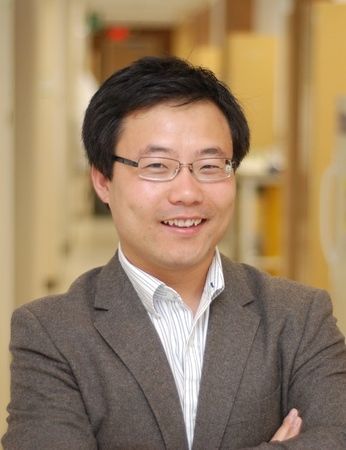 | Keynote Presentation Rapid and Ultra-sensitive Diagnostics Using Digital Detection
Weian Zhao, Associate Professor, Department of Biomedical Engineering, University of California-Irvine, United States of America
We will present our most recent droplet based digital detection
platforms for rapid and sensitive detections, which could find potential
applications at the point-of-care (POC). |
| 17:35 | 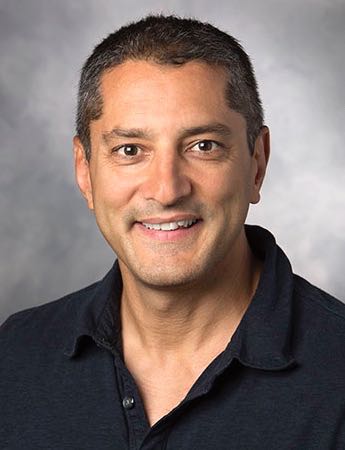 | Keynote Presentation Fractionation and Analysis of Nuclear versus Cytoplasmic Nucleic Acids from Single Cells
Juan Santiago, Charles Lee Powell Foundation Professor, Stanford University, United States of America
Single cell analyses (SCA) have become powerful tools in the study
heterogeneous cell populations such as tumors and developing embryos.
However, fractionating and analyzing nuclear versus cytoplasmic
fractions of nucleic acids remains a challenge as these fractions easily
cross-contaminate. We present a novel microfluidic system that can
fractionate and deliver nucleic acid (NA) fractions from the nucleus
(nNA) versus the cytoplasm (cNA) from single cells to independent
downstream analyses. Our technique leverages a selective electrical
lysis which disrupts the cell’s (outer) cytoplasmic membrane, while
leaving the nucleus relatively intact. We selectively extract, purify,
and preconcentrate cNA using isotachophoresis (ITP). The ITP-focused
cNA and nNA-containing nucleus are separated by ITP and fractionated at a
bifurcation downstream and then extracted for off chip analyses. We
will present example applications of this fractionation including qPCR
and next generation sequencing (NGS) analyses of cNA vs. nNA. This will
include preliminary NGS analyses of nuclear vs. cytoplasmic RNA
fractions to analyze gene expression and splicing. We hypothesize that
the robust and precise nature of our electric field control is amenable
to further automation to increase throughput while removing manuals
steps. |
| 17:55 |  | Keynote Presentation Chip-Scale Microfluidic Physiological Circulation Systems
Abraham Lee, Chancellor’s Professor, Biomedical Engineering & Director, Center for Advanced Design & Manufacturing of Integrated Microfluidics, University of California-Irvine, United States of America
There has been a recent surge in the development of microphysiological systems and organ-on-a-chip for drug screening and regenerative medicine. Over the years, drug screening has mostly been carried out on 2D monolayers in well plates and the drugs are not delivered through blood vessels as in vivo treatments. Through the advancement of microfluidics technologies, we have enabled the automation of biological fluids delivery through physiological vasculature networks that mimic the physiological circulation of the human body. The critical bottleneck is to engineer the microenvironment for the formation of vascularized 3D tissues and to also pump and perfuse the tissue vascular network for on-chip microcirculation. This in vitro model system can be used to screen cancer drugs by mimicking the delivery of the drugs through capillary blood vessels. On the other hand, microfluidics play an important role in the recent advances in liquid biopsy and the ability to specifically isolate and capture rare cells such as circulating tumor cells. These two technologies may go hand-in-hand to connect in vitro screening to in vivo screening with great potential in the development of personalized medicine.
|
| 18:15 | Close of STRATEC Consumables Symposium | 18:30 | Cocktail Reception for All Conference Attendees: Enjoy Beer, Wine, Appetizers and Network with Fellow Delegates, Speakers, Exhibitors in the Exhibit Hall and View Posters Sponsored by STRATEC Consumables GmbH | 20:00 | Close of Day 2 of the Conference. Continue Networking in Downtown San Diego (Trolleys to the City are Available Right Behind the Conference Venue). | 20:00 - 22:00 Dinner Training Course
Organ-on-a-Chip: Technologies, Applications and Commercial Opportunities
Presented by:
Professor Michael Shuler, Samuel B. Eckert Professor of Engineering, Cornell University; President & CEO, Hesperos, Inc.
Professor James Hickman, Professor, University of Central Florida; Chief Scientist, Hesperos, Inc.
- September 27, 2016 from 20:00-22:00
- Dinner will be served
- Separate Registration Required
|
Wednesday, 28 September 201607:30 | Morning Coffee and Breakfast Pastries | |
Session Title: From Technologies to Utility -- Applications of Microfluidics/LOAC in Life Sciences and Beyond |
| | 08:00 | Micro-encapsulation of Carbon Dioxide Capture Solvents Through Microfluidic Processing
Congwang Ye, Research Staff, Lawrence Livermore National Laboratory, United States of America
Microfluidics have been developed for many applications such as life science research and lab-on-a-chip. At LLNL, our work focuses on using microfluidics to produce microcapsules for energy application, particularly the capture of CO2. Recently, new designer solvents have been developed to reduce energy cost for carbon capture. However, they suffer from many drawbacks such as high viscosity, solid precipitates and corrosivity. Separating the capture solvent with a gas permeable shell provides a practical pathway to use these solvents. In our lab, double emulsion drops were generated within a micro capillary device and are composed of liquid capture solvents as the core and different polymer precursor solutions as the shell layer. After crosslinking the polymer shell, the resulting microcapsules are mechanically robust and can be handled in fixed-bed, moving-bed or fluidized-bed reactors for different applications. While the mass transfer of gas through the capsule shell is slightly lower when compared to neat liquid sorbents, the increase in surface area enhances the overall CO2 absorption rate by 3.5-10x based on experimental data. The absorbed CO2 can then be released by heat or diffusion for reuse applications or underground storage. | 08:30 | 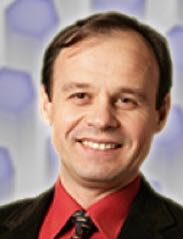 | Keynote Presentation A New Generation of Centrifugal Microfluidics Platforms Using Active Electronic and Pneumatic Controls
Teodor Veres, Section Head, Bioanalytical Micro-Nano Devices, Life Sciences Division, National Research Council of Canada & McGill University, Canada
Integration of complex bioanalytical assays in microfluidics is a considerable challenge, requiring not only precise control on fluid displacements but also development of simple and reliable microfluidic devices that are compatible with low-cost mass production. While centrifugal microfluidics is a promising platform for sample-to-answer assays, the traditional fluidic control methods based on capillary and siphon valves have many drawbacks (thigh fabrication tolerances, need for surface treatments, sensitivity to liquid properties, low-reliability, etc.). We have developed new centrifugal microfluidic platforms that offer the interesting prospect to decouple basic microfluidic functions from specific material properties, channels dimensions and fabrication tolerances, surface treatments, or on-chip active components, thus promoting integration of complex assays on simple and low-cost microfluidic cartridges. We present several novel fluidic functions that can be achieved using simple polymer-based chips without on-chip active components by combining centrifugal forces and active pumping. Examples of integrated bioanalytical assays will be discussed including DNA harvesting, pathogenic bacteria sub-typing and circulating makers sample preparation for molecular identification will be presented. |
| 09:00 |  Technology Spotlight: Technology Spotlight:
Laser Micro-Machining for Lab-on-a-Chip Applications
Sergey Broude, Senior Technical Fellow, Resonetics, LLC
Laser micro-machining occupies a special niche among methods available for chip fabrication. This presentation will describe its benefits, achievable results and limitations, as they apply at different scales and phases of chip development and production.
| 09:30 |  Technology Spotlight: Technology Spotlight:
Innovative Flow Control Solutions For a Wide Variety of Applications
Anne Le Nel, CSO, Fluigent
Microfluidics is seeing an increasing interest from its original use by fluidic and engineering groups now evolving to chemists and biologists in academic and industrial settings. This transformation in applications has dictated new experimental requirements that need to be dealt with, especially for applications where flow control is critical. Our method to control multiple flow rates based on pressure actuation is presented. An algorithm has been developed to automatically adjust the applied pressure to reach the targeted flow-rates. The ability to control and monitor both pressure and flow-rate is the core of this technology. Very fast settling times, excellent stability for liquid and gas handling, specific flow profiles, robustness and high repeatability can be easily achieved. Different functionalities such as buffer selection/recirculation or even detection synchronization combined with automation tools will be presented. Specific flow control platforms have been developed for different applications like organ-on-a-chip, cell culture, lab-on-a-chip, flow cytometry, as well as quality control for high-throughput screening.
| 10:00 |  Technology Spotlight: Technology Spotlight:
A Benchtop Microfluidic Platform for Culturing Tissue with Live Imaging Under Physiological Flow Conditions
Thomas Corso, Chief Technical Officer, CorSolutions
To date, tissue culture with live imaging under physiological flow conditions is challenging. To address these difficulties CorSolutions has developed a Benchtop Microfluidic Culture Platform for studying tissue culture under physiologically relevant conditions outside of an incubator. This flexible, universal platform incorporates fluidic interconnects, pulse-free fluid delivery pumps, and optics to offer a simple alternative to the conventional incubator. The Benchtop Microfluidic Culture Platform can interface a variety of microfluidic devices to the macro world. To evaluate the platform, perfused microvessels consisting of human umbilical cord vascular endothelial cells, expressing green fluorescent protein, were cultured. The approach allowed for live cell imaging while subjecting the culture to the physiological shear stress of 15 dynes/cm2, throughout the 3 day experiment. The results showed an unexpected active migration of cells both with and against the flow, including traversal of the branching channels, and their eventual alignment and polarization in the direction of flow. The live imaging revealed cell behavior that had never before been observed as endothelial cells had been believed to be quiescent, undergoing mitosis only once every one to two years. Although the implications of the observed cell migrations are not yet known, it is clear that the Benchtop Microfluidic Culture Platform is a tool with tremendous potential for probing cellular behavior.
| 10:30 | Coffee Break and Networking in the Exhibit Hall: Visit Exhibitors and Poster Viewing | 11:15 |  Technology Spotlight: Technology Spotlight:
Using the Analytical Objective as the Organizing Principle for POC Development
Leanna Levine, Founder & CEO, ALine, Inc.
Engineers often think about the overall package for the microfluidic cartridge, and then drill down to develop the fluidic circuit. But this approach fails to address the complexity in getting the performance from the assay with the biological reagents; the heart of a POC product. In this presentation, we will discuss a development approach in which the Analytical Objective for the product is used to drive the microfluidic development program so that the product meets the level of quantitation, sensitivity, and dynamic range needed to be competitive in the marketplace.
| 11:45 |  Technology Spotlight: Technology Spotlight:
Innovative Solutions for Next-Generation Biotechnology Devices
Bernd Dielacher, Business Development Manager, EV Group (EVG)
To successfully commercialize modern chip-based biotechnology devices in a fast growing market with stringent requirements and high regulatory hurdles, precise and cost-effective micro-structuring technologies are essential. Nanoimprint lithography (NIL) has evolved from a niche technology to a powerful high-volume manufacturing method that is able to serve today’s needs and overcome the challenges of increasing complexity of microfluidic and lab-on-a-chip devices. NIL is a patterning technique with unique capabilities to produce a multitude of different sizes and shapes on a large scale by imprinting either into a biocompatible resist or directly into the bulk material with resolutions down to 20 nm. The presentation will discuss NIL technologies, such as hot-embossing, UV-NIL and micro-contact-printing. In addition to structuring technologies, sealing and encapsulation is a central process for establishing confined microfluidic channels. Thus, bonding of different device layers, capping layers or interconnection layers is a key process that can be implemented together with NIL in a cost-effective large-area batch process which will be also reviewed in this presentation. Together with bonding processes that are well aligned with NIL structuring techniques, limitations of current fabrication methods can be overcome to enable the production for next-generation biotechnology devices.
| 12:15 | Networking Lunch in the Exhibit Hall: Visit Exhibitors and Poster Viewing | |
Session Title: Technology Advances in Microfluidics |
| | 13:30 |  Technology Spotlight: Technology Spotlight:
Recombinase Polymerase Amplification (RPA): An Isothermal DNA Amplification Method Enabling Point-of-Care Microfluidic-based Diagnostics
David Brooks, Head of Clinical & Business Development, TwistDx Ltd.
RPA offers PCR equivalent specificity and sensitivity and lends itself to microfluidic application due to a low working temperature, rapid amplification, lyophilised reagents stored at ambient temperature, small reaction volumes, and multiple detection formats such as lateral flow, fluorescence, and electrochemistry. A number of users have successfully deployed RPA assays on to a range of microfluidic platforms such as quantitative digital, emulsion droplet, centrifugation, and using various read-out modalities. Assays for numerous targets have been developed such as for food pathogens, human IVDs, and GMO in food products. We will review some of these embodiments of microfluidic RPA usage that illustrate the potential of the biochemistry.
| 14:00 | Microfluidic Generation and Study of High Viscosity Biopolymer Capsules for Biology Applications
Frederic Bottausci, Senior Engineer, Commissariat à l’Energie Atomique et aux Energies Alternatives (CEA), France
Microcapsules for cell encapsulation (used for diabetes therapy for instance) are generated with high viscous biopolymer using a plastic cartridge based technology on a microfluidic platform. The capsules generation is studied experimentally using µPIV, numerical and analytical models. | 14:30 | Design of a Lab-on-a-Chip for the Quantitation of S-Nitrosothiols: From their Separation to their Decomposition and Electrochemical Detection
Anne Varenne, Professor, Chimie ParisTech, Unité de Technologies Chimiques et Biologiques pour la Santé, France
NO is a diatomic free radical that has in biological fluids extremely
short half-life (<1 s). The addition of NO to functional proteins is
as important as phosphorylation in its consequences on cellular
activities. In order to be transported and stocked in biological fluids,
NO binds to peptides and proteins forming S-nitrosothiols (RSNOs). The
variation of their proportion has been recognized in many diseases.
RSNO are sensitive to decomposition by light, heat, and metal ions.
RSNOs can exchange the NO between one other by transnitrosation
reaction. Recently we studied the separation of different RSNOs and
their transnitrosation reaction using capillary electrophoresis with
capacitively coupled contactless conductivity detection. Also, we
developed a decomposition process of RSNO using copper to quantify RSNO
by electrochemical techniques (ultra-micro electrodes). We are currently
down scaling these approaches within microchip devices. This opens the
way for an integrated lab-on-a-chip for S-nitrosothiols quantitation. | 15:00 | Cation Dependent Transport in Gated Nanofluidic Systems
Shaurya Prakash, Associate Professor, Department of Mechanical and Aerospace Engineering, The Ohio State University, United States of America
A nanofluidic device with an embedded and fluidically isolated gate
electrode, analogous to solid state semiconductor field effect
transistors was developed for exquisite ionic transport control.
Specifically, the gated electric field allows for tunable control of
both the magnitude and direction of the net ionic current through the
nanochannels as a function of electrolyte concentration and gate
electrode location permitting device operation as a multi-state switch.
Additionally, we show that ion transport is cation dependent for
negatively charged walls demonstrating that engineered surface charge
can potentially lead to significant advances in separations and
nanoscale selective ion transport. | 15:30 | Our Oceans, Our Health: Technology for In-Situ Sample Analysis of Coastal Waters
James Birch, Director, SURF Center, Monterey Bay Aquarium Research Institute, United States of America
Humans depend on and are influenced by the ocean. Obvious impacts are food production, weather, and climate. Less obvious may be the contributions of plant and microbial communities; for instance, 70% of the oxygen in our atmosphere comes from phytoplankton photosynthesis. Despite this importance to all life, the oceans have proven quite difficult to study, in part because access can be difficult and costly. At MBARI we are designing, testing, and deploying instruments that address these access issues. The analytical side of these instruments is modeled after the tools and techniques derived from the biomedical diagnostics and research industries. Coupling these analytical techniques with traditional oceanographic sensors that characterize the physical, chemical and optical properties of ocean waters has led to the concept of the ‘ecogenomic sensor’, a device that can apply molecular analytical techniques in situ. | 16:00 | Analysis of S-Nitrosothiols Using Paper-based Microfluidic Device (µPAD) by Colorimetry: Kinetics of Decomposition and Quantification
Abdulghani Ismail, Researcher, Chimie ParisTech, Unité de Technologies Chimiques et Biologiques pour la Santé, France
A disposable microfluidic paper-based analytical device (µPAD) was developed to easily analyze different S-nitrosothiols (RSNOs) through colorimetric measurements. RSNOs are carriers of nitric oxide (NO) that plays several physiological and physiopathological roles. The quantitation of RSNOs relies on their decomposition using several protocols and colorimetric detection of the final product, NO or nitrite. µPADs were fabricated by wax printing technology in a circular geometry for decomposition and detection of decayed products interconnected by microfluidic channels and one central sample inlet zone. Different decomposition protocols including mercuric ion and light (UV, Visible, and Infrared) were tested on µPADs. A 3D printed holder was coupled with µPADs to make easy a simultaneous decomposition procedure using different light sources. Griess reagent was then added to detect NO and nitrite produced by the different decomposition methods. µPADs were then scanned using a flat board scanner. The limit of detection (LOD) values for nitrite and S-nitrosoglutathione (GSNO) using mercuric decomposition were 3 µM and 4 µM, respectively. The LOD reported herein is considered one of the lowest LOD already reported using paper microfluidic devices. The results also show that low molecular weight RSNO, namely S-nitrosocysteine decomposes more easily than high molecular weight RSNOs by light. | 16:30 | Surface Functionalization Strategies for the Design of Thermoplastic Microfluidic Devices for New Analytical Diagnostics
Fanny d'Orlyé, Associate Professor, Chimie ParisTech, Unité de Technologies Chimiques et Biologiques pour la Santé, France
Cyclic olefin copolymer (COC) and fluoropolymer (Dyneon THV) are
emerging materials attractive for the conception of microfluidic chips
thanks to their UV-visible transparency and high resistance to
aggressive solvents. We propose to develop new analytical microsystems
using these polymers for trace quantitation in complex matrices. This
involves the immobilization of selective ligands in a confined zone of
the microchannel for target extraction and preconcentration. This
integrated pretreatment step will be followed inside the microdevice by
electrokinetic separation and on-line detection. This requires new
surface treatments for chemically inert COC and Dyneon to modify the
microfluidic system at two scales: (1) on the entire surface to control
surface properties and fluid flows during electrokinetic separation, or
(2) locally to immobilize selective ligands (aptamers) on restricted
areas for target extraction. For global modification, a plasma-induced
immobilization of brominated derivatives allowed further ligand
immobilization through alkyne-azide “click” chemistry reaction. For
local ligand immobilization, we developed an original electrochemical
strategy on Dyneon THV microchannel. Local electrochemical carbonization
followed by covalent linkage of ligands (aptamers) through “click”
reaction leads to immobilization zones in the 50 micrometer range. | 17:00 | Close of Conference Track. |
|


 Add to Calendar ▼2016-09-26 00:00:002016-09-28 00:00:00Europe/LondonLab-on-a-Chip and Microfluidics: Companies, Technologies and CommercializationSELECTBIOenquiries@selectbiosciences.com
Add to Calendar ▼2016-09-26 00:00:002016-09-28 00:00:00Europe/LondonLab-on-a-Chip and Microfluidics: Companies, Technologies and CommercializationSELECTBIOenquiries@selectbiosciences.com